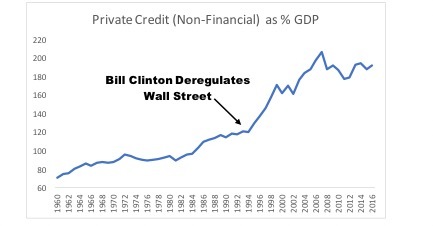
Photo Source Paul Sableman | CC BY 2.0
As if on special at Metaphors-R-Us, and just in time for the primary elections, CNN published an article on fake buttons that are provided to give people the illusion of control. It seems psychologists determined that fake buttons at crosswalks, in elevators and in other public and quasi-public places convey a sense of control without the power of control. In the space between upcoming elections and the creeping realization that connected capitalists still control the country, the question is of what reform candidates can really accomplish?
Staying with the metaphor for a minute, of relevance is that these buttons are engineered illusions— they are intended to deceive. The modes of existing they are designed to facilitate— office dwelling, high-rise living and urban traffic, preceded the psychologists’ additions. The fake controls are a response to adverse reactions to these modes of living. The question left unasked is: why are people having adverse reactions to the absence of control? The follow-on question is: what are the human consequences of the distance between the illusion and real control?
The progressives running in upcoming elections seem to be decent enough people. And reflexive cynicism— say about the plausibility of reform politics, only passes for knowledge in some particularly deplorable circle of hell. With apologies, welcome to hell. National Democrat Nancy Pelosi is promising to preclude all of the irresponsible social spending on progressive programs with ‘pay-go,’ the national Democrats’ austerity-in-a-can. And the New York Times is endorsing Andrew Cuomo over Cynthia Nixon because (corrupt machine politician) Cuomo can better ‘stop Trump.’

Graph: Given the relationship of economic distribution to political power, it is a good proxy for the distribution of political power. Since the 1980s a rising proportion of national product has been shifted from working class workers to the very rich. This is the result of specific policies designed to accomplish this outcome, not nature. When national Democrats proclaim themselves to be capitalists, this is the economic distribution they support. Source: LA Times / World Inequality Database.
‘New’ Democrat Cuomo, who has governed as a Republican, would seem an odd choice to stop Trump if that were the goal. With Wall Street downstate from the governor’s mansion and Manhattan real estate serving as a money-laundering mechanism for the global looting class, Mr. Cuomo is Donald Trump’s ex-bootlick / errand person running New York’s patronage system. It is this intersection of real estate and global money laundering that made Donald Trump the titan of inheritance capitalism he is. Alas, promoting otherwise unelectable Democrats has long seemed the subtext of the ‘stop Trump’ campaign.
Economic austerity, the mantra and clarified butter of the national Democrats, is the claim that the only legitimate expenditures by the Federal government are for unnecessary wars, Wall Street bailouts and prisons. Other expenditures— for housing, education, health care, food and retirement, are burdens on our children and grandchildren. If this reads like the program of the radical right, you might be on to something. And if you don’t understand the implications for bottom-up political reform, please read on.
The institutional backdrop is that the Federal government (‘public’) and banks (‘private’) create money. State and local governments can borrow, but they are otherwise constrained by the revenues they collect. Why then would Ms. Pelosi suggest that Federal spending is constrained by revenues (via the Federal budget) when it isn’t? More broadly, why has this been Democratic Party dogma since Bill Clinton assumed office? Don’t they want for their constituents to be fed, housed, educated, healthy and retired in security? Phrased more plainly, why do they hate their constituents?

Graph: When Bill Clinton entered office as president in 1993 he immediately reneged on his campaign promise to increase social spending citing the budget deficit as the reason. Shortly thereafter (non-financial) private debt (as a percent of GDP) began to rise rapidly as government spending was replaced with bank loans. This increased profits for Wall Street until excessive private debt killed the economy in 2007. National Democrats favor economic austerity because it increases profits for Wall Street. Source: Worldbank.
Money creation is politically important because it is a control device for social spending. How far is democratic socialism likely to get if the Federal purse strings are controlled by committed capitalists in the Federal government? Is it incidental that Ms. Pelosi is restating the national Democrats’ commitment to fiscal probity while single-payer healthcare, federally funded college education and a Federal job guarantee are being put forward as components of the progressives’ program? Lest this remain unclear, the national Democrats are telling progressives to take a hike.
Missing from progressive consciousness appears to be a plausible explanation for the national Democrats’ fiscal obsession. In olden times banks earned profits by making loans. Government spending funds public investment that could otherwise be financed through bank loans. Additionally, inflation— the alleged result of ‘excess’ public investment and / or household income, reduces the purchasing power of bank loans when they are repaid. Wall Street hates public investment almost as much as it hates inflation. National Democrats are the Party of Wall Street. Ergo, national Democrats hate public investment almost as much as they hate inflation.
Is it incidental then that the first modern President of Wall Street, Bill Clinton, introduced economic austerity to the national Democrats’ canon? It was ex-Goldman Sachs Co-Chair Robert Rubin who, as Mr. Clinton’s Treasury Secretary, explained the ‘tyranny of the bond market’ to Mr. Clinton. At the time economist John Kenneth Galbraith explained that the New Democrats’ patrons-to-be thrived on human misery. To close the circle. Wall Street thrives on human misery, national Democrats are the Party of Wall Street, ergo national Democrats thrive on human misery.
A weltanschauung was demonstrated when Barack Obama bailed out Wall Street and quickly followed up with calls for economic austerity. His quest to ‘get the banks lending again’ in the face of excessive private debt was to favor bank loans over public expenditures. The ‘lesson’ of the Great Depression was that the public expenditures of the New Deal revivified American capitalism. But why piss-off Wall Street patrons and counter IMF prognostications for ‘lesser’ countries when Wall Street can make debt-slaves of the entire populace? There is an economic logic to manufacturing human misery.
The predictable result, that a few already rich people were made richer to the outer bounds of human avarice while everyone else was stuck in a public-private partnership of engineered downward mobility, is the program that Ms. Pelosi and the national Democrats intend to move forward. The apparent calculation is that Donald Trump is so widely loathed that they can run on an austerity program and counter the reformers and democratic socialists through control of the public purse. Republicans certainly aren’t going to come to their aid by advocating public spending on social programs.
As has been commented on quite effectively elsewhere, the irony of the Democratic establishment’s support for largely white, largely male establishment candidates— see Andrew Cuomo above, against their identity-politics dream-team challengers— Ms. Nixon is female and lesbian, exposes the tactic as a fraud. The prevalent explanation— that the political stakes are too high, begs the question of why they are so high? This isn’t to claim they aren’t, but rather to ask why austerity economics is still central to the Democrats’ program given the electoral losses that have followed its implementation?
With not much implied beyond what is written, a difference between Occupy Wall Street and the #Resistance is the choice of targets. As the center of American finance capitalism, Wall Street controls American political economy. Bringing Wall Street to heel would solve a lot of social iniquities. The #Resistance poses one person, Donald Trump, as ‘the problem’ implying that getting him out of office would solve everything that needs to be solved. In fact, Wall Street and the American ruling class would still control most of what matters.
The question regarding elections is: do they change the distribution of power? Again, the Federal government and banks can create financing giving them fundamentally different levers of social control than state and local governments possess. This is a problem for bottom-up electoral strategies— the purse strings are controlled by people and groups with contrary interests and the economic power to get their way. Running on platforms that suggest otherwise is a recipe for one-term ‘insurgencies.’
It is ironic, and perhaps wholly coincidental, that insurgent groups as diverse as Occupy Wall Street and the Black Panthers were shut down when they began demonstrating that they could build (small scale, ultimately utopian) alternative institutions. Elections are intended to change the cast of characters without challenging existing institutions. This is what Nancy Pelosi is making clear through her re-statement of the Democrat’s commitment to economic austerity. And it would seem to imply that the greatest impediment to progressive programs comes from establishment Democrats.
Without changing the distribution of power, elections are the fake buttons of politics— they provide the illusion of political control without its fact. This is a central reason why I have resisted the #Resistance assertion that Donald Trump is ‘the problem’— underlying political economy is little changed between administrations. Current problems were set in motion with the ascendance of finance capitalism beginning in the 1970s. I plan to vote for the ‘insurgents’ and hope they are successful with their stated programs. Otherwise, building alternative institutions seems the more promising path.